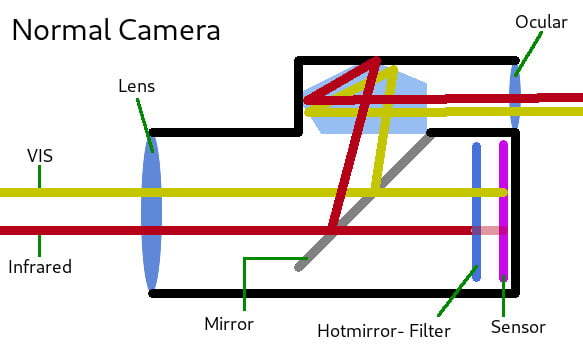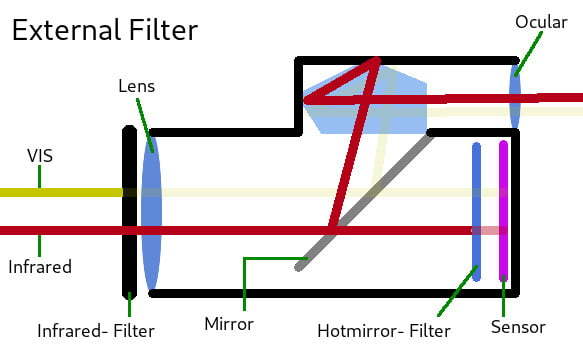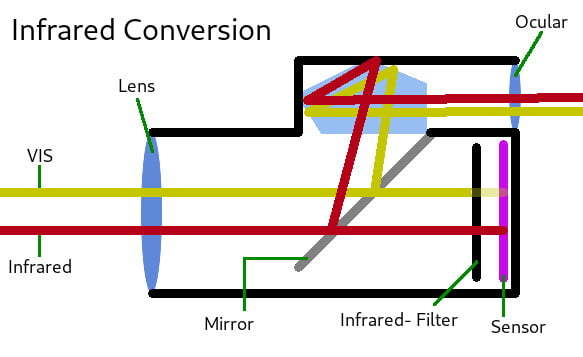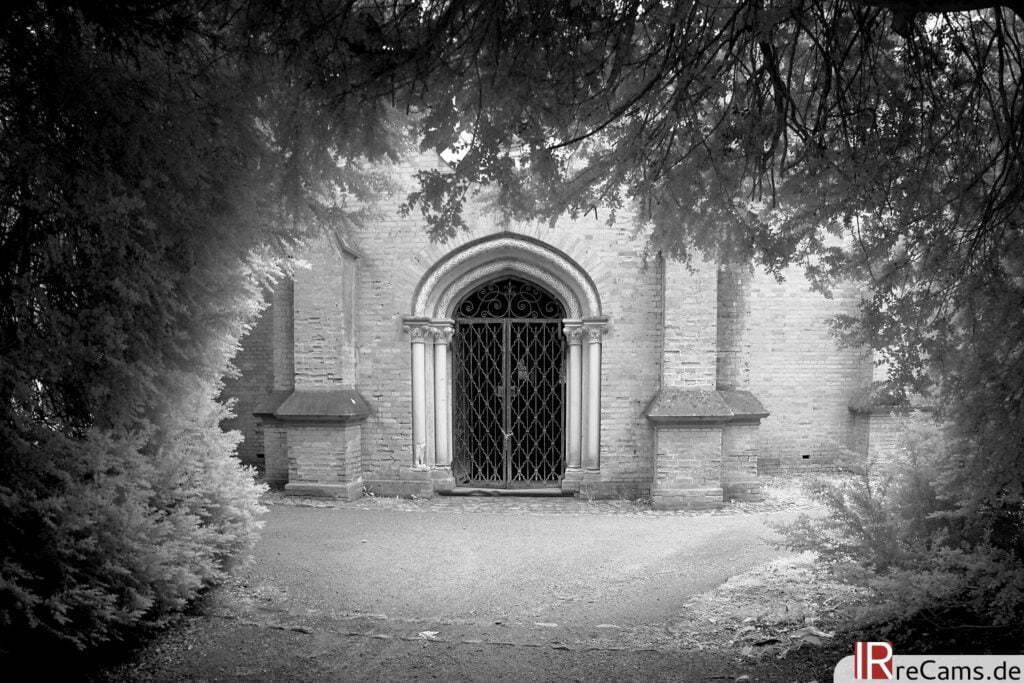Your shopping cart is currently empty!
Infrared conversion - technique explained
Using a normal digital camera for infrared photography is theoretically possible, but actually not recommended. Only an infrared conversion opens up all possibilities and allows high quality images. But why does infrared photography not work with normal cameras and what are the different possibilities for DSLR and mirrorless digital cameras?
How digital cameras work
Unlike our eyes, the sensor of a digital camera has the ability to "see" in the infrared range. Modern digital cameras with CMOS or CCD sensors are generally sensitive between 350 nm and 1200 nm. For even longer-wave infrared radiation, there are special thermal imaging cameras whose sensors are not based on silicon. So what we record with IR photography, the near infrared radiation, has nothing to do with heat.
Camera manufacturers purposely install a filter in front of the sensor that only allows the VIS range onto the sensor and blocks both UV and IR.

The so-called hotmirror filter makes a great contribution to image sharpness and color reproduction in classic digital photography. For infrared photographers, however, this filter is a pain in the neck.
Infrared Photography with screw-on filter
Fortunately, on many older camera models the hotmirror filter does not block 100 % of the IR spectrum. To test your own camera, you can hold a remote control in front of the lens and press as many buttons as possible. Does the infrared diode light up visibly in the image? If so, it is possible to use this camera with an infrared screw-on filter in front of the lens.
The additional filter blocks visible light and only allows light above a certain wavelength (typically 720 nm) to pass through.

Unfortunately, there is still the hotmirror filter, which blocks a large part of the IR light. As a result, on a sunny day outdoors we have to expose for a very long time (in the seconds range) and absolutely need a tripod. It is also important to know that there is a focus shift in the infrared range. For more details see section "Lenses and image errors". As the IR filter is located in front of the lens and we cannot see through it, it is impossible to adjust the image composition or set the focus correctly without taking several test shots. Even with LiveView, this is usually a problem because very little light hits the sensor.
Full Spectrum Conversion
So why not just throw out the hotmirror filter? On modern camera models, this blocks almost 100 % of IR light, which is why infrared photography with a screw-in filter is not really an option. Although it is not a good idea to simply remove the filter, because the focus position then shifts completely, you can replace the filter.
With a "clear glass" that allows UV, VIS and IR to pass through, this is referred to as a full spectrum conversion. To photograph in IR, you need additional screw-in filters.

A camera that has been converted to full spectrum has the advantage that it can be used very flexibly, because a wide range of different lenses can be positioned in front of the lens. Infrared Filters can be screwed on. With such an infrared conversion (also known as an undefined conversion), you can choose to photograph in the UV, VIS or IR range. With the right filter you can even take completely normal pictures in the visible range again, as if there had been no infrared conversion at all. The usual short exposure times can be achieved with both IR filters and hotmirror screw-in filters.
With an DSLR camera, you are unfortunately forced to compose the image and adjust the focus via the LiveView function. A full spectrum conversion is especially recommended for mirrorless cameras. Unlike with a DSLR, the viewfinder can be used as usual and autofocus and exposure metering also work without restrictions.
Dedicated infrared conversion
For ambitious infrared photographers who know exactly what they want, the first choice is a completely converted infrared camera. Installing the IR filter directly in the camera has advantages, especially with digital SLR cameras. Image composition in the bright viewfinder is possible, even if nothing looks like infrared. The autofocus is corrected with a professional infrared conversion and can therefore be used "as normal". Exposure metering works after the conversion in the same way as before, except that exposure correction is required depending on the shooting situation.
The hotmirror filter is replaced by a corresponding infrared filter so that only infrared light reaches the sensor. An external screw-in filter is no longer required.

After an infrared conversion, the camera photographs exclusively in the IR range. This means that the usual short exposure times are possible, even hand-held, of course. However, it is not possible to take "normal" pictures in the visible range with such a camera. Nevertheless, depending on the built-in filter, other screw-in filters can be combined if necessary. An overview of the compatible filters can be found for each screw-in filter in the Shop.
The true costs of digital infrared photography
Removing and replacing the blocking filter is a technically complex act, professionally carried out it is an investment that cannot be overlooked. In addition, a camera has to be "sacrificed" for this, which can no longer be used for anything other than infrared photography. Without wishing to minimize this, it is. Unfortunately, there are no practical alternatives to replacing the blocking filter if you really want to achieve high-quality results.
Camera manufacturers are bringing new technology onto the market at ever shorter intervals. Many of us still have an older model at home that is rarely used, even though it still takes great pictures. But selling these old cameras is hardly worthwhile. With an IR conversion, this camera is given a second life. And hand on heart: how much money have you invested in your lenses? An infrared camera offers many more creative possibilities than "just" a single lens, and that for all existing lenses.

